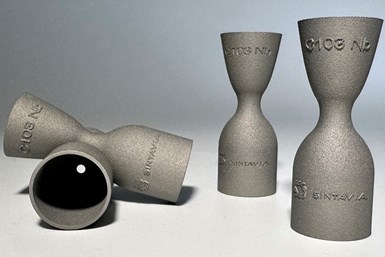Sintavia Develops Niobium Printing Technology for Aerospace, Defense
C103 material parameter specification is said to enable full alloy adoption across defense and space applications.
Share
Read Next
Sintavia — a designer and additive manufacturer of complex mechanical systems for the aerospace, defense and space industry — has developed material parameters for alloy C103, a high-performance niobium alloy which is well suited for rocket, jet and satellite propulsion applications.
The refractory metal, which is difficult to print without extensive parameter development, was developed on an EOS M290 printer and represents the 29th material parameter developed by Sintavia for use by its aerospace, defense and space OEM customers.
The mechanical properties of Sintavia’s C103 include an as-printed density of 99.94% and a Z-direction elongation of 32% after a standard stress relief cycle. Full performance data for Sintavia’s C103 parameter set can be found on the company’s website.
“Due to its extremely high melting point, niobium is widely recognized as an excellent material for space propulsion applications, specifically reaction control thrusters and attitude control thrusters,” says Pavlo Earle, Sintavia’s vice president of technology engineering. “With this development, Sintavia is able to offer its space customers components that embody industry-leading mechanical properties. When combined with Sintavia’s equally best-in-class design and additive production capability, our C103 parameters offer our customers a high-quality and reliable industrial solution for extreme temperature applications.”
Sintavia is currently developing standards for other refractory materials for use across the aerospace, defense and space industry. The company designs and 3D prints advanced propulsion and thermodynamic systems for customers in the aerospace and defense industry. A founding member of the Additive Manufacturer Green Trade Association, Sintavia is committed to the highest quality standards in the industry and holds multiple Nadcap and other aerospace accreditations.
- Additive manufacturing has not yet fully confronted all the factors that contribute to sustainability. Learn how Sintavia is discovering and working through these issues in metal AM as its production work scales.
- Read about Sintavia’s development of proprietary copper printing technology which is designed for use with GRCop-42, the preferred copper alloy used by NASA and private space flight companies for rocket thrust chamber assemblies.
Related Content
-
EOS Works With Phillips Federal, Austal USA to Develop CopperAlloy CuNi30 for US Navy Submarine Industrial Base
Using the copper-nickel alloy in combination with EOS’ platforms offers new design and production capabilities for U.S. Navy submarines, while also enabling the agency to limit global supply chain disruption because parts can be produced regionally, locally and on-demand.
-
How a DOD-Funded Resilient Manufacturing Ecosystem (RME) Is Coming Together at Neighborhood 91
Pittsburgh’s additive manufacturing campus doubles as a test bed for a Department of Defense project aimed at developing a reproducible ecosystem for on-demand production of critical parts.
-
DOD Drives Transformation with New AM Policy
The U.S. Department of Defense published DODI 5000.93, a comprehensive plan for implementing additive manufacturing among military services.
















